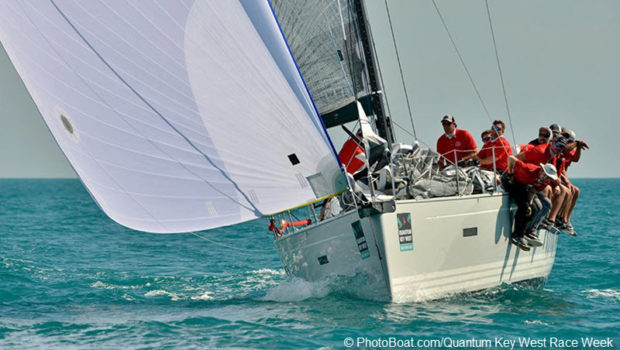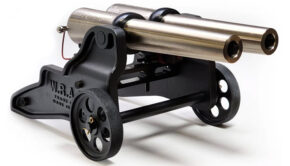Eight Rules for Racing the Racer/Cruiser
Published on February 22nd, 2017
Quantum Sail’s David Flynn has spent years helping cruisers with their competitive bug. In a perfect world you could have a boat for every need, but if you’re like most of us and your budget only allows for a one boat program, Dave is here to help with his eight rules for racing your racer cruiser.
Any hardcore core racing sailor will tell you that the whole concept of a dual-purpose racer/cruiser is an oxymoron. They are correct. A purpose-built racing boat will always ultimately beat even the best prepared racer cruiser all things being equal. So ideally if you want to be competitive you need a boat to race and a boat to cruise. And then there are some who will only race one design. If only budgets and lifestyles made such choices easy.
In the real world, such purity of purpose may not always be possible. You may only get one boat. You may like to race and cruise. You may not have the luxury of great one design in your area. Or you may be attracted to the concept of racing something a bit more comfortable and solid. You may simply like the way your boat looks. No matter what you end up trying to race, there are certain tried and true techniques that all successful programs, regardless of competitive level, have in common. Rules to live by if you want to race your racer/cruiser well.
Rule #1 Don’t try to race more boat than you can afford
The cost of buying a boat is actually the least expensive part. It’s the operation costs that kill. A used J-35 may seem like a steal until you have to buy a couple of $5,000 genoas. Define your goals. It may be as simple as winning your local Wednesday night series, or as tough as being at the top of your class at Quantum Key West Race Week. Put together a realistic budget to insure that you have the right tools and can afford the logistics.
Rule #2 Pick your venue
Handicap rules are imperfect and frustrating at times. It is still hard to compare apples and oranges, so they always work best when boats are of a similar size and style. It will never be easy to rate a displacement racer/cruiser versus a high-performance boat capable of planing. There will be horses for courses. So, pick your venue wisely.
It may be tough to toss your 40-50 racer cruiser complete with cockpit seats and cabin top around the cans at Key West, but she might be great on longer point to point races where there is less emphasis on crew mechanics and acceleration.
No matter what the event, take a look at the scratch sheet and see where you are going to end up. Is there a huge speed/rating difference in the class? Are you going to be the smallest/slowest rated boat? Is the venue known for light air? If the answer is yes to these questions you might want to consider another regatta. Look for events that feature classes of other displacement racer cruisers of similar size. Target races that have the potential for more wind.
Rule #3 It’s all about the team
Put together a consistent team. You don’t necessarily need rock stars, but you need to have the same players over a long period of time. There is no substitute for time in the boat and time together. The common thread that I have seen over all my years of racing is that the skippers that take the best care of their crews end up (can you imagine?) having the best crews.
It could be as simple as great cold beer and after race dinner at the local bar on a Wednesday night, or as rich as a killer house and a cook at a major event. You don’t have to pay crew but you do need to take good care of them. Everybody wants to sail on a well-prepared boat where they are treated well. It’s a cost that has to be factored in.
Rule #4 Put your boat on a diet
Racing sailboats is like racing anything else. Ultimately it all comes down to horsepower to weight ratio. In some instances, you can add horsepower. Bigger spinnakers, larger mainsail roaches, or longer spinnaker poles may be in order. But the cheapest way to improve the ratio in your favor is to remove weight. It’s the only part of the game that is free!
Racer/cruisers are notorious for being heavier than advertised and for collecting additional weight over time. Empty everything out. Don’t ask if you need it, just put it on the dock. If you are getting really serious and are using a rule where you will be physically measured, you might consider taking out doors, cushions, bow thruster, anchor windlasses, furling systems, stoves, – anything that is legal.
Take your cruising gear and store in carefully marked containers. When you are ready to go cruising, put the cooking gear, the spares, the bedding, the books all back on.
Rule #5 Your bottom is worth every dime you spend
A smooth, fair, hard polished bottom is a basic requirement for success. Every hour spent fairing and refining your bottom, keel, and rudder will pay for itself on the course. Ultimately you would use templates (if available) to insure the shape and fairness of your blades. Most racer/cruisers come from the factory with a lot of room for improvement. Paint and sand. There are hard bottom paints which can be burnished and still offer reasonable protection against marine growth.
Rule #6 You need good sails
As a sailmaker, this is certainly incredibly self-serving, but don’t take my word for it. Ask any serious professional or top sailor. Fresh, high-quality sails are the engine. Can’t skimp on the engine. Newer sails are always better no matter what we make them out of or what we (as sailmakers) say about how long they will last. That is why hours and tacks are logged at the top levels.
If you are racing at a local level on weekends and weeknights, start with a fresh inventory and plan to add a sail or two a year to keep it fresh. If you are planning an ambitious schedule with four or five major regattas, you will need to add multiple sails a year. Ideally you will have good back-ups that you can practice with or go to lower-key events with so you protect your first-string sails. So, before that jib is toast, build a new one so the original model can become the practice jib.
Rule #7 Upgrade your systems and rigging
Racer/cruisers often suffer from, how shall we put this delicately, “less than optimal” sail handling systems. The mainsail traveler needs to work. You have to have enough purchase to pull on the mainsheet. The backstay adjuster has to be accessible and easy to use, jib leads easy to adjust. To trim effectively and to have the ability to shift gears, systems have to work and be user-friendly.
This is more difficult when you have lots of stuff in the way that is not there on a pure race boat. It may take a little creative thought. Invariably, the running rigging packages (halyards and sheets) that come standard will not be very good. Invest in quality line. Stretch is the enemy, robbing power from the sails and making it harder to pull on things. Good line will also reduce friction and help save a little weight.
Rule #8 Practice!
Racing sailboats is a sport. You can’t expect to show up on race day and sail well if you haven’t spent some time with your team working on mechanics and figuring out trim and set up. Take your Wednesday night crew out for a practice session the week before the first race, or, even better, schedule a weekend day. If you are going to a big regatta, add in a day or two on the front end. It will be time well spent.
Source: Quantum Sails, originally published in Spinsheet Magazine.









 We’ll keep your information safe.
We’ll keep your information safe.